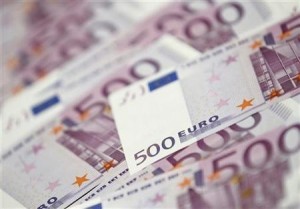 The euro advanced to the strongest level in six weeks against the US dollar, after a report revealed today that the New York Federal Reserve’s index of manufacturing conditions declined more sharply than expected in February, adding to speculations the Federal Reserve may slow the pace of tapering stimulus as the US economy seems to lose momentum.
The euro advanced to the strongest level in six weeks against the US dollar, after a report revealed today that the New York Federal Reserve’s index of manufacturing conditions declined more sharply than expected in February, adding to speculations the Federal Reserve may slow the pace of tapering stimulus as the US economy seems to lose momentum.
EUR/USD touched a 6-week high at 1.3770 at 14;12 GMT, after which consolidation followed at 1.3764, adding 0.42% for the day. Support was likely to be received at February 17th low, 1.3692, while resistance was to be encountered at January 2nd high, 1.3775.
Greenbacks demand was dampened after the index, which tracks the manufacturing activity in the state of New York, came in at 4.48 this month, defying analysts estimates of a drop to 9.50 and after the index climbed to 12.51 in January, the highest since May 2012. Also fanning negative sentiment, the new orders index dropped to zero, after it reached 11 last month, the highest reading in two years.
Tomorrow, the Federal Reserve Bank is scheduled to release the minutes of its January policy meeting.
The central bank trimmed its monthly bond buying program from $85 billion to $65 billion after two $10 billion cuts. The Fed Chairman Janet Yellen cited the harsh winter and the unseasonably low temperatures as probable reasons for the weaker-than-expected US economic data, as the cold weather has affected activity in the labor market and elsewhere.
The Federal Reserve announced its latest decision to reduce monthly monetary stimulus by 10 billion USD to 65 billion USD at the meeting on policy in January, underscoring that labor market indicators, which “were mixed but on balance showed further improvement”, while nation’s economic growth has “picked up in recent quarters.” Fed policymakers are to hold their next meeting on March 18th-19th.
The Federal Reserve will probably continue to pare stimulus, which tends to devalue the greenback, by $10 billion at each policy meeting before exiting the program in December, according to a Bloomberg News survey of 41 economists, conducted on January 10th.
Meanwhile, the euro was pressured earlier in the day after data showed a gauge that tracks investors confidence in the largest euro zone economy, Germany, fell for a second month in February. A report by the ZEW Center for European Economic Research revealed its index of investor and analyst expectations, declined to 55.7 in February from 61.7 in the previous month. The index, aimed to forecast economic developments six months in advance, reached a seven-year high of 62.0 in December.
“The ZEW report from Germany disappointed this morning,” Arnaud Scarpaci, a Paris-based fund manager at Montaigne Capital, which manages about $271 million, said in a Bloomberg interview today. “I have been overweight in Europe this year and now am inclined to reduce my exposure.”
However, the German current conditions sub-index improved to the strongest level in 2-1/2 years, reaching 50.0 in February from 41.2 a month ago, outstripping analysts expectations for an increase to 44.0.
The euro zone ZEW economic sentiment also decreased to 68.5 in February from 73.3 in the previous month, confounding analysts projections for an increase to 73.9.
However, a report by the European Central Bank revealed that the seasonally adjusted current account surplus of the euro area widened to 21.3 billion euros in December, the most since March 2013.
Elsewhere, GBP/USD hit a session high at 1.6742 at 06:05 GMT, after which the pair erased daily gains to trade at 1.6699 at 11:08 GMT, losing 0.1% for the day. Support was likely to be received at February 14th low, 1.6645, while resistance was to be encountered at yesterday’s daily high of 1.6823, also the pair’s strongest since November 2009.





